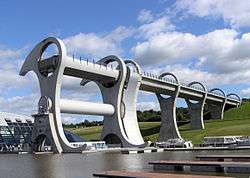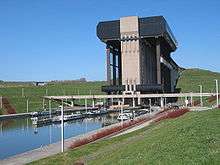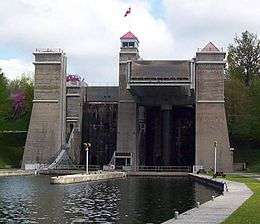Boat lift
A boat lift, ship lift, or lift lock is a machine for transporting boats between water at two different elevations, and is an alternative to the canal lock and the canal inclined plane.

It may be either vertically moving, like the ship lifts in Germany, Belgium, the lift at "Les Fontinettes" in France or the Anderton boat lift in England, or rotational, like the Falkirk Wheel in Scotland.
History
A precursor to the canal boat lift, able to move full-sized canal boats, was the tub boat lift used in mining, able to raise and lower the 2.5 ton tub boats then in use. An experimental system was in use on the Churprinz mining canal in Halsbrücke near Dresden. It lifted boats 7 m (23 ft) using a moveable hoist rather than caissons. The lift operated between 1789 and 1868,[1] and for a period of time after its opening engineer James Green reporting that five had been built between 1796 and 1830. He credited the invention to Dr James Anderson of Edinburgh.[2]
The idea of a boat lift for canals can be traced back to a design based on balanced water-filled caissons in Erasmus Darwin's Commonplace Book (page 58-59) dated 1777–1778[3]
In 1796 an experimental balance lock was designed by James Fussell and constructed at Mells on the Dorset and Somerset Canal, though this project was never completed.[2] A similar design was used for lifts on the tub boat section of the Grand Western Canal entered into operation in 1835 becoming the first non experimental boat lifts in Britain.[4] and pre-dating the Anderton Boat Lift by 40 years.
In 1904 the Peterborough Lift Lock designed by Richard Birdsall Rogers opened in Canada. This 19.8-metre (65 ft) high lift system is operated by gravity alone, with the upper bay of the two bay system loaded with an additional 30 cm (12 in) of water as to give it greater weight.
Before the construction of the Three Gorges Dam Ship Lift, the highest boat lift, with a 73.15-metre (240.0 ft) height difference and European Class IV (1350 tonne) capacity, was the Strépy-Thieu boat lift in Belgium opened in 2002.
The ship lift at the Three Gorges Dam, completed in January 2016, is 113 m (371 ft) high and able to lift vessels of up to 3,000 tons displacement.
The boat lift at Longtan is reported to be even higher in total with a maximum vertical lift of 179 m (587 ft) in two stages when completed.[5]
Selected lift locks
| Name | Location | Opened | Displacement | Dimensions | Vertical lift | Cycle time | Notes |
|---|---|---|---|---|---|---|---|
| Three Gorges dam ship lift | China | 2016 | 3000 tons | 280 by 35 by 5 metres 919 by 115 by 16 feet |
113 metres 371 feet | 30–40 minutes | |
| Krasnoyarsk Dam ship lift | Russia | 1982 | 1500 tons | 90 m × 18 m × 2.2 m 295 ft × 59 ft × 7 ft |
104 m 341 ft | 90 minutes | |
| Ronquières inclined plane lift | Belgium | 1968 | 1350 tons | 91 m × 12 m × 3.7 m 299 ft × 39 ft × 12 ft |
67.73 m 222 ft | 22 minutes[6] | |
| Strépy-Thieu boat lift | Belgium | 2002 | 1350 tons | 112 m × 12 m × 3.35 m 367 ft × 39 ft × 11 ft |
73.15 m 240 ft | 7 minutes | |
| Scharnebeck twin ship lift | Germany | 1974 | 1350 tons | 105.4 m × 15.8 m × 3.4 m 346 ft × 52 ft × 11 ft |
38 m 125 ft | 3 minutes | |
| Niederfinow boat lift | Germany | 1934 | 85 m × 12 m × 2.5 m 279 ft × 39 ft × 8 ft |
36 m 118 ft | 20 minutes | ||
| Peterborough lift lock | Canada | 1904 | 1300 tons | 42.7 m × 10.1 m × 2.1 m 140 ft × 33 ft × 7 ft |
19.8 m 65 ft | 10 minutes | |
| Kirkfield Lift Lock | Canada | 1907 | 1300 tons | 42.7 m × 10.1 m × 2.1 m 140 ft × 33 ft × 7 ft |
14.9 m 49 ft | 10 minutes | |
| Rothensee boat lift | Germany | 1938 | 1000 tons | 85 m × 12.2 m 279 ft × 40 ft |
16 m 52 ft | 20 minutes | |
| Falkirk Wheel | Scotland | 2002 | 600 tons | 21.33 m × 6 m × 1.37 m 70 ft × 20 ft × 4 ft |
24 m 79 fts | 4 minutes | |
| Henrichenburg boat lift | Germany | 1962 | 600 tons | 67 m × 8.2 m × 2 m 220 ft × 27 ft × 7 ft |
14 m 46 ft | 25 minutes | |
| Danjiangkou Dam | China | 1973 | 450 tons | ||||
| Geheyan Dam ship lift | China | 1987 | 300 tons | ||||
| Longtan Dam ship lift | China | 2009? | 250 tons | 40 m × 10.8 m × 1.8 m 131 ft × 35 ft × 6 ft |
68.5 m 225 ft | claimed to be the "fastest ship-lift in the world" | |
| Canal du Centre boat lifts | Belgium | 1888–1917 | 360 tons/350 tons | 40.1 m × 5.06 m × 2 m 132 ft × 17 ft × 7 ft |
16.93–15.4 m 56–51 ft | three lifts each 16.93 m high plus one 15.4 m high | |
| Fontinettes boat lift | France | 1881–88 | 300 tons | 39 m × 5.2 m × 2 m 128 ft × 17 ft × 7 ft |
13.13 m 43 ft | 5 minutes | |
| Anderton boat lift | UK | 1875 | 250 tons | 22.9 m × 4.7 m × 2.9 m 75 ft × 15 ft × 10 ft |
15.25 m 50 ft |
See also
- List of boat lifts
- Lock (water transport)
- Balance lock
- Canal inclined plane – another technique for lifting boats.
- Caisson lock: a submerged boat lift.
- Shiplift – used for raising vessels in shipyards
- Marine railway inclined plane for shipyards
- Water slope
- Saint-Louis-Arzviller boat lift, France – which is actually a canal inclined plane
- Portable boat lift
- Patent slip
References
- Charles Hadfield World Canals: Inland Navigation Past and Present Page 71 ISBN 0-7153-8555-0
- The Canals of Southwest England Charles Hadfield Page 104 ISBN 0-7153-8645-X
- "revolutionaryplayers.org.uk". Archived from the original on 2 April 2012. Retrieved 1 September 2016.
- The Canals of Southwest England Charles Hadfield Page 109 ISBN 0-7153-8645-X
- "Long Tan Hydroelectric Dam". 2007. Retrieved 2010-05-20.
- "The inclined plane of Ronquières". Archived from the original on 11 June 2008. Retrieved 1 September 2016.
Further reading
- Tew, David (1984). Canal Inclines and Lifts. Sutton Books. ISBN 0-86299-031-9.
- Uhlemann, Hans-Joachim (2002). Canal lifts and inclines of the world (English Translation ed.). Internat. ISBN 0-9543181-1-0.
External links
| Wikimedia Commons has media related to Boat lifts. |
- "The lift-locks on the Canal du Centre, at Houdeng and Strépy-Thieu, Belgium". 2005-05-14. Archived from the original on 2007-08-25. Retrieved 2007-09-14. Source mentions its own sources
- The International Canal Monuments List
- ^ Three Gorges Dam
- Big Chute, Ontario – in fact an inclined plane
- Twin Ship Elevator Lüneburg - Technical data of the Scharnebeck twin ship lift near Lüneburg, Germany
- Dutch boat lift page

